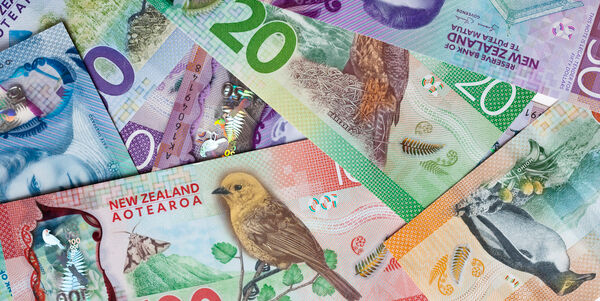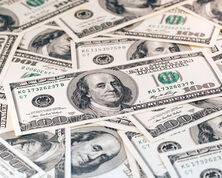
Ever looked closely at the banknotes in your wallet? Beyond the security features and colourful designs, you'll find remarkable individuals gracing each note. From pioneering explorers to champions of social justice, these figures represent the rich history of New Zealand's identity. Join us on a journey as we delve into the lives and achievements of the iconic New Zealanders celebrated on their national currency.
This is the third part of a blog series exploring the faces that adorn banknotes.
New Zealand's currency journey began with British influence. Before 1840, there wasn't a single official currency. Instead, banks often issued their own currency, which circulated alongside British coins and Australian gold sovereigns. In 1840, New Zealand adopted the British pound and then, in 1933, the New Zealand Pound (pegged to the British Pound).
A shift came in 1967 with the introduction of the New Zealand dollar, nicknamed the 'Kiwi' for its image on the one-dollar coin. This move embraced a decimal system, making transactions simpler. The design originally featured the British monarch, but over time, it has developed to incorporate more Kiwi iconography, a unique and proud representation of New Zealand's national identity.

The New Zealand dollar's value wasn't always freely determined. Initially, it was pegged to the US dollar, then a basket of currencies. Finally, in 1985, the Kiwi 'floated,' meaning its worth is based on the foreign exchange market. However, the Reserve Bank's ability to intervene and manage its value provides a reassuring stability to the currency.
Today, the New Zealand dollar is not just a significant player but a powerhouse in the global market, ranking among the top twenty most traded currencies globally - a testament to the country's evolution from a British colony to a nation with a unique and influential currency, showcasing the country's global influence and economic prowess.
$5 note - Edmund Hillary
Legendary New Zealand mountaineer Sir Edmund Hillary graces the $5 note. Hillary wasn't just any climber; in 1953, alongside Tenzing Norgay, he became one of the first two people confirmed to reach the summit of Mount Everest, the highest point on Earth. This historic feat cemented his status as a national hero.
Beyond Everest, Hillary explored Antarctica and championed the Sherpa people of Nepal through his Himalayan Trust charity. His adventurous spirit, resilience, and dedication to humanitarian work perfectly embody New Zealand's pioneering spirit, earning him a well-deserved spot on the country's currency.
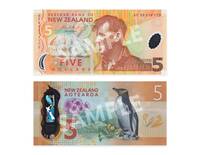
The NZ $5 note is a colourful tribute to exploration and nature. On the front, alongside Sir Edmund Hillary, Aoraki/Mt Cook, New Zealand's highest peak, and a Massey Ferguson tractor are featured, symbolising the nation's agricultural heritage. Turn it over, and you'll discover a captivating scene from Campbell Island featuring the rare hoiho (yellow-eyed penguin) among sub-antarctic flora.
The bill, identified by its bold orange colouring, is made of a durable polymer that is difficult to tear. A clear window reveals intricate details that shift when tilted, including ferns and koru patterns and the number five (the denomination of the note). Tiny puzzle pieces on both sides, visible when held to light, form a complete number five. These features make forgery difficult and help ensure the integrity of New Zealand's currency.
$10 note - Kate Sheppard
Kate Sheppard, a champion of women's rights, adorns the New Zealand $10 note. Through tireless efforts – petitions, public meetings, and persuasive writing – Sheppard rallied support for women's right to vote. In 1893, New Zealand became the first country in the world to grant all women the right to vote, a historic achievement credited largely to Sheppard's leadership.
Her image on the $10 note signifies the nation's immense value on equality and democracy. The white camellia beside her portrait is a further nod to the suffrage movement, as these flowers were given to legislators who supported women's voting rights.
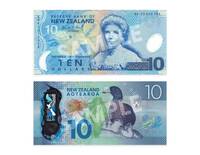
Take a look on the reverse of the $10 note and you'll find a glimpse into the country's natural beauty through the depiction of a river scene including elements like:
- Whio (blue duck): This flightless duck, known for its distinctive blue plumage, is New Zealand's rarest waterfowl. In 1903, it became the first NZ bird species to become fully protected. Featuring it raises awareness about endangered native species.
- Pineapple scrub: Named as such due to its leaves that resemble those of a pineapple, this plant is found exclusively in the southwestern areas of the South Island and Stewart Island.
- Blechnum fern (kiokio): A common native fern with distinctive green fronds, the kiokio signifies the remarkable resilience of New Zealand's plant life, instilling a sense of hope and optimism.
$20 note - Elizabeth II
Queen Elizabeth II, the long-reigning monarch of New Zealand, graces the front of the $20 note. Her portrait symbolised New Zealand's ties to the British Commonwealth and her role as the country's sovereign. Alongside the late monarch's portrait are images of the New Zealand Parliament in Wellington, and the more modern 'Beehive' Executive Wing, built between 1969 and 1977.
Following the Queen's passing in September 2022, New Zealand's Reserve Bank announced a future transition. The $20 note will eventually feature King Charles III. However, existing notes remain legal tender, and the switch won't happen for several years until current stocks are depleted.
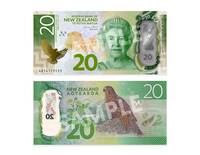
As a nod to the nation's breathtaking landscapes and its commitment to protecting its delicate natural heritage, the reverse of the $20 note features an alpine scene and includes elements such as:
- Kārearea (New Zealand falcon): Soaring through the scene is the kārearea, a native falcon known for its speed and agility.
- Marlborough rock daisy: These delicate white flowers, endemic to NZ, grow across the country often in inaccessible places.
- Mount Tapuae-O-Uenuku: Among the country's tallest mountains, this iconic peak's name translates in Maori to "footprint of the rainbow".
$50 note - Sir Āpirana Ngata
Sir Āpirana Ngata was a prominent statesman, often described as the foremost Maori politician to have served in parliament in the mid-20th century. A champion in promoting and protecting Māori culture and identity, he played a pivotal role in the Māori Renaissance, a revival movement that aimed to preserve and revitalise Māori traditions, language, and land rights. He challenged the traditional views of his people, advocating the abandonment of some traditional practices and healing techniques in favour of modern science-backed medicine, which made him a controversial figure.
Ngata's image on the $50 note recognises his immense contribution to New Zealand's cultural landscape. He advocated for the preservation of Māori carvings, meeting houses (wharenui), and traditional knowledge.
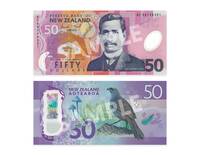
Further elements of New Zealand's unique flora and fauna can be found on the reverse of the $50 note. Take a look and you'll see:
- Kōkako (blue-wattled crow): This large, shy forest bird with distinctive blue-grey plumage is a threatened species. Featuring it on the note raises awareness about protecting New Zealand's endangered wildlife.
- Pureora Forest Park: Centrally located on the North Island, this park stretches across 78,000 hectares and is one of the most ecologically significant forests in New Zealand.
- Sky-blue mushroom: This brightly, almost unnaturally coloured but delicate fungus grows throughout New Zealand. It represents the unique biodiversity found in New Zealand's forests.
$100 note - Ernest Rutherford
Ernest Rutherford, a pioneering nuclear physicist, takes centre stage on the New Zealand $100 note. He wasn't just any scientist; his groundbreaking work revolutionised our understanding of the atom. Nicknamed "the father of nuclear physics," Rutherford conducted experiments that discovered the atomic nucleus and the concept of protons within it. He also achieved the first artificial nuclear transmutation, changing one element into another. Born in New Zealand, Rutherford's scientific achievements earned him international acclaim, including the 1908 Nobel Prize in Chemistry.
His image on the $100 note signifies New Zealand's pride in scientific innovation. The Nobel Prize medal and a graph depicting his radioactivity research are also featured, highlighting his specific contributions. Rutherford's pioneering spirit and global impact make him a well-deserved symbol on New Zealand's highest denomination banknote.
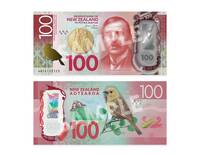
The flip side of the New Zealand $100 note showcases more of the country's stunning natural world. Key elements include:
- Mohua (yellowhead): This vibrant yellow-headed bird, also known as the pōkākā, is a threatened species endemic to New Zealand. Featuring it raises awareness about conservation efforts.
- Eglinton Valley: Situated in the Fjordland National Park, Eglinton Valley is home to one of only a handful of large areas of lowland beech forest and unique wildlife found nowhere else in the country or world.
- Red beech: These towering trees can grow up to 30m high and are named as such because of the colouring of their young leaves. They are the favoured habitat of the yellowheads in Eglinton Valley, near Milford Sound.
- South Island lichen moth: This small, intricately patterned moth, sometimes known as the Zebra moth, is found in the beech forests of the Fjordlands where it blends perfectly with the lichens that cling to the trunks of trees.

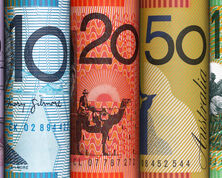
Ben Tully
Visual Design & Content Creation
Ben deals with all things design, working on the visual design of our annual guides, Destinations magazine, information leaflets, social media and email campaigns, and much more across the Alan Rogers, Rallies and Worldwide brands. He also produces written content for our blogs alongside our other contributors.
More by Ben TullyRecent Blog Posts
-
Explore the World Your Way
February 13, 2025 -
Guest Post: A Journey through the Parks and Lakes of Western Canada
October 28, 2024 -
Rhythms of the South: Celebrating the Sounds of Southern Soul, Gospel and Funk
October 10, 2024 -
Rhythms of the South: Exploring the Soul of Memphis Blues, Soul and Rock 'n' Roll
October 2, 2024 -
Rhythms of the South: A Journey Through the Jazz and Dixieland Roots of New Orleans
September 24, 2024
